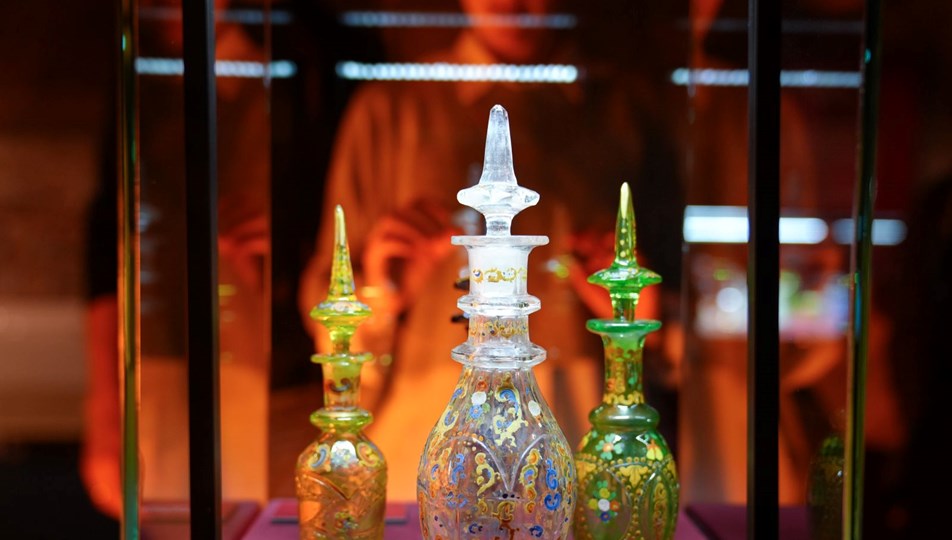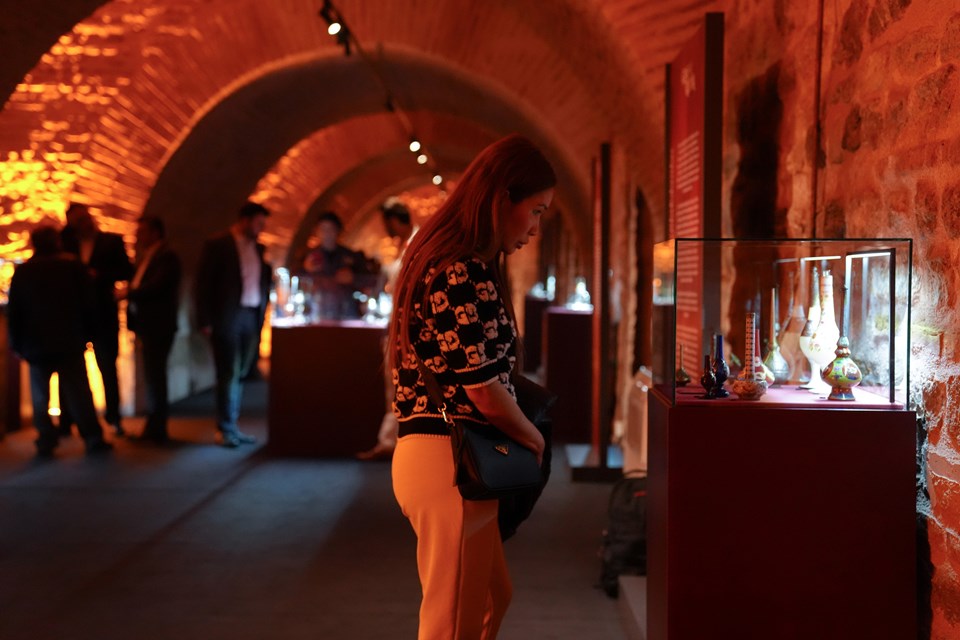Gılaf-ı Reyya: Fragrance Bottles from the Ottoman Empire to the Present Day exhibition opened
The exhibition Gılaf-ı Reyya: Fragrance Bottles from the Ottoman Empire to the Present opened at the Turkish and Islamic Arts Museum.

The exhibition "Gılaf-ı Reyya: Fragrance Bottles from the Ottoman Empire to the Present" created from the collection of collector Bekir Kantarcı opened at the Turkish and Islamic Arts Museum. The exhibition presented a selection of fragrance bottles from the 18th century to the mid-20th century to the taste of art lovers.
Bekir Kantarcı, in his statement to AA, stated that the story of the exhibition dates back 35 years and said, "I became interested in scents during my university years. Over time, my relationship with scents transformed from an interest to a professional one. The issue gradually grew with processes such as researching the production and design processes of scents and bottles, following international fairs, visiting perfume museums, and reading books on old perfumes. At that time, I did not imagine myself as a collector, but I had an ideal, albeit small. At this point, this journey that started with a dream turned into a rich collection. The biggest reason for this was my interest in art, culture, and the rich heritage of our civilization."
Kantarcı, who stated that the roots of the exhibition go back to the "Perfume" museum he opened in the Grand Bazaar, expressed his happiness for bringing together with art lovers a well-organized accumulation of perfumes, bottles, scent art and history from the Ottoman period to the present.
Kantarcı said that scent had become an industrial and synthetic trading product since the 1850s, and added, "Before this date, scent was too valuable, scarce and expensive. Even now, we live in a world where one gram of ambergris is sold for 150 dollars. In the past, the bottles that provided the preservation and presentation of such a valuable product were also extremely valuable and had high aesthetic value in line with the scent. One of the most important points of our exhibition is to emphasize exactly this situation." Noting that commercial concerns are effective in scent production and consumption, as in every sector, Kantarcı provided the following information:
"Now, scent is a product that everyone can easily smell. But on the contrary, the purity of scent is unfortunately disappearing. This is a very sad situation for us. Right now, the same scents are almost everywhere. The exception to this is the Arabian Peninsula. They preserve their own authentic scent, ambergris. Nowadays, the world's most important brands are investing in these scents, trying to produce arabesque and oriental scents and highlight them. With such commercial concern, scent manufacturers are offering the Arabian scent to the whole world. Because it is the authentic one. This is the reason why oud, which no one knew about or valued until recently, has become so valuable."
"EVLIYA CELEBI SAYS THERE ARE MORE THAN TWO THOUSAND SMELLERS IN ISTANBUL"
Bekir Kantarcı, drawing attention to the fact that scent and the culture formed around scent began with the history of humanity, said, "Scent is based on a very rich cultural history. It would not be wrong to talk about a history of scent. Scent is a product that has both personal and aesthetic value and an important function in the contact established with the divine. Therefore, it is possible to understand scent as an element of beauty that constantly refines and develops. In our own tradition, our Prophet, to put it figuratively, said, 'I was made to love beautiful scents.' With the hadith, scent becomes a very important and central element for both Arabs and Turks. Musk, amber and oud appear as the most important elements of our culture in a wide geography and time period from the Seljuks to the Ottomans. In all this rich literature, while I was doing research on scent raw materials and how and where these substances were formed, the thing that I came across and impressed me the most was Evliya Çelebi's statement that there were more than two thousand scent makers in Istanbul. These are specialized scent makers. Evliya Çelebi states that there were only shops selling rose, lavender or amber. This shows us how rich a scent culture dominated the period."
"THE BASIC STARTING POINT OF THE EXHIBITION IS TO PRESENT FINE SCENT COVERS"
The exhibition curator Beste Gürsu also pointed out that the subtitle of the exhibition is "Scent Bottles from the Ottomans to the Present Day". Emphasizing that they used the expression "Gılaf-ı Reyya" as the main title in reference to the Ottomans, Gürsu said, "Reyya means beautiful, gılaf means cover. Therefore, we are presenting beautiful scent covers to our visitors here. This is the basic starting point of our exhibition. During the inventory work we conducted with Bekir Bey, we saw that scent and the culture that developed with it have positively affected humanity throughout the ages. Everyone, whether poor or rich, used to use a scent. Therefore, we have a very rich tradition before us. Our selection represents only a part of this richness."
Gürsu emphasized that exhibiting an object means bringing that object to the public sphere, and therefore they have prepared a selection that can appeal to different ideas and expectations. Emphasizing that there are a wide range of products in the selection, Gürsu said, "In this selection that started from the Ottoman Empire and continues to the present day, we tried to include different scent samples, from rosewater flasks and incense burners that have entered literature to the Beykoz Bottle Factory and the bottles produced there, and from ceramics and porcelains produced by cultures such as Europe, China and Asia. Our exhibition also includes scents used by noblemen in English palaces, as well as pocket flasks and the most important necklaces of scent culture that have invaluable value as jewelry. We wanted to present this rich culture to art lovers with an exhibition that has a high representational power."

Beste Gürsu underlined that scent has both a human and spiritual meaning and noted:
"Your soul must love the scent first. A scent is a product that makes you happy and affects you throughout the day. If you choose such a product correctly, first from its external form, that is, its case, the first thing that appeals to you in this sense is the scent's bottle. By trying the product in a bottle you like, you will find the beautiful scent in the right bottle. In short, the bottle and the scent become one, and what you buy is exactly this unity. Therefore, as important as producing a scent is, designing a bottle and creating a product with high artistic value is at least as important. Because it is not only the scent that ensures the continuation of culture, but also the form in which you present that scent."
Pointing out that scent has lost its former richness and that this situation is similar throughout the world, Gürsu said, "For example, Europe does not have a scent to offer the world. There is a lack of identity there because everything is intertwined. The incense in European churches, the ouds of the Arabs, the rose water of the Ottomans are the authentic scent traditions and examples of three different societies. However, scent has not only a personal but also an otherworldly meaning and the dialogue of the spiritual power in Europe with scent is no longer like ours. We still love rose water, offer it, and use it. However, there is a weakness in this regard in Europe. In a place where everything is materialized, genuine scent is unfortunately gradually disappearing." The exhibition, which was organized with the contributions of Kuveyt Türk Participation Bank, can be visited until May 22.
News Link: Gılaf-ı Reyya: Fragrance Bottles Exhibition from the Ottoman Empire to the Present Opened
Author: NTV - (Anadolu Agency)

Share:
Fair Magazine | KISWAH Company Owner Bekir Kantarcı: Our Fair is High Quality and Receives Great Interest! - 19/04/2024
Yeni Şafak | A Lifetime in Pursuit of the Scent of the Prophet - 7/05/2024